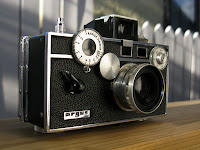
I just read Nate Silver's book,
The Signal and the Noise, so of course that allows me to steal his title. I'm not going to actually say anything much about the book except to note the phenomenon under examination is evident in the book's reception and reviews. I'm amused that the Republican pundits accused Silver of a liberal bias because he was predicting an Obama win. Given his faultless performance in both the national and state races, Silver is obviously a competent number cruncher; he also seems to me to be a pretty much standard-issue libertarian geek of the type one finds hanging out at Slashdot.
The signal to noise ratio is something we all must deal with constantly in all of life's aspects, but it's seeming more overwhelming the last couple decades due to the rise of computing and the internet. One sees the problem expressed very often in regard to photo history and criticism as bad ideas, bad history and bad analysis get propagated and reproduced at the speed of light. Of course, the origins of the problem are pre-computer age, but the exponential propagation takes us into new territory.
I got to thinking about this topic recently when I was writing about Edward Weston's life and work. I googled "f.64" which was the name of a group organized originally in 1932 to promote a photo exhibit of a half-dozen proponents of straight photography which included Weston. I was dismayed to see that the Wikipedia reference on the subject was a hopeless misrepresentation of history. The comparison with the earlier tradition of pictorialism was muddled by confusion over terminology, and the positions of predecessors and pioneers like Stieglitz was completely misrepresented. The so-called f.64 manifesto was featured as if it represented something other than exhibition hyperbole.
i.e.:
"..Pure photography is defined as possessing no qualities of technique, composition or idea, derivative of any other art form..."
I think Willard Van Dyke may have penned that; it has to be rated as one of the silliest things said at any place or time about photography. Ansel Adams, a smart member of the group, amended the statement to the point of refutation later, but that has not prevented it from being propagated ad nauseum.
Weston wrote quite a lot about photography and much of that is well worth reading, but he had his blind spots as well, particularly as related to his own work, and those too have clogged both the analogue and digital channels of photography's history. For instance, Weston often referred to the reality and "thingness" of his subjects, but much of his most lauded work with nudes, nature and still life consists of abstract representations. Janet Malcolm laid out the issues around these conflicts between stated intent and execution in a review of a Weston retrospective which took place in New York in 1975:
"The sight of these strange, strong compositions casts doubt on another accepted idea about Weston. This is his presumed role in the history of photography as a prime mover in the revolution that over-threw the "pictorial" approach of the Photo-Secession and established "straight" photography as the medium's legitimate mode. In actuality, what Weston did (as Paul Strand and Man Ray had already begun to do) was simply to bring pictorialism up to date: to replace the Impressionist, Symbolist, and Pre-Raphaelite models of the Photo Secession with those of Cubist, Futurist, Dadaist, Purist, and Surrealist art. Straight photography -- whatever it is -- is hardly exemplified by peppers like clenched fists...,thighs like shells, shells like vulvas, cloud formations like elongated torsos.., palm trunks like industrial smokestacks -- forms that Weston saw because he had seen modern art...
...The technical innovations of straight photography that were erected into a kind of religion by its practitioners -- the change from soft-focus to sharp lenses, from manipulated to unretouched prints, from warm and soft to cold and glossy printing paper -- were, again, changes dictated by the appearance of modern art rather than by the claims of "reality." Optical sharpness, after all, is more an attribute of the buzzard's than of the human eye; Stieglitz's blurry view of the thin Flatiron Building on a snowy day is surely a more literal rendering of "the thing itself" than Weston's razor-sharp close-up of a halved artichoke."
 The first camera I bought for myself was an Argus C3. That would have been about 1958 when I was just out of high school. Argus was still making the camera, but I got mine used in a pawn shop. I don't recall exactly what became of that first one; I've bought several more in the last ten years and have enjoyed shooting them again.
The first camera I bought for myself was an Argus C3. That would have been about 1958 when I was just out of high school. Argus was still making the camera, but I got mine used in a pawn shop. I don't recall exactly what became of that first one; I've bought several more in the last ten years and have enjoyed shooting them again. 





